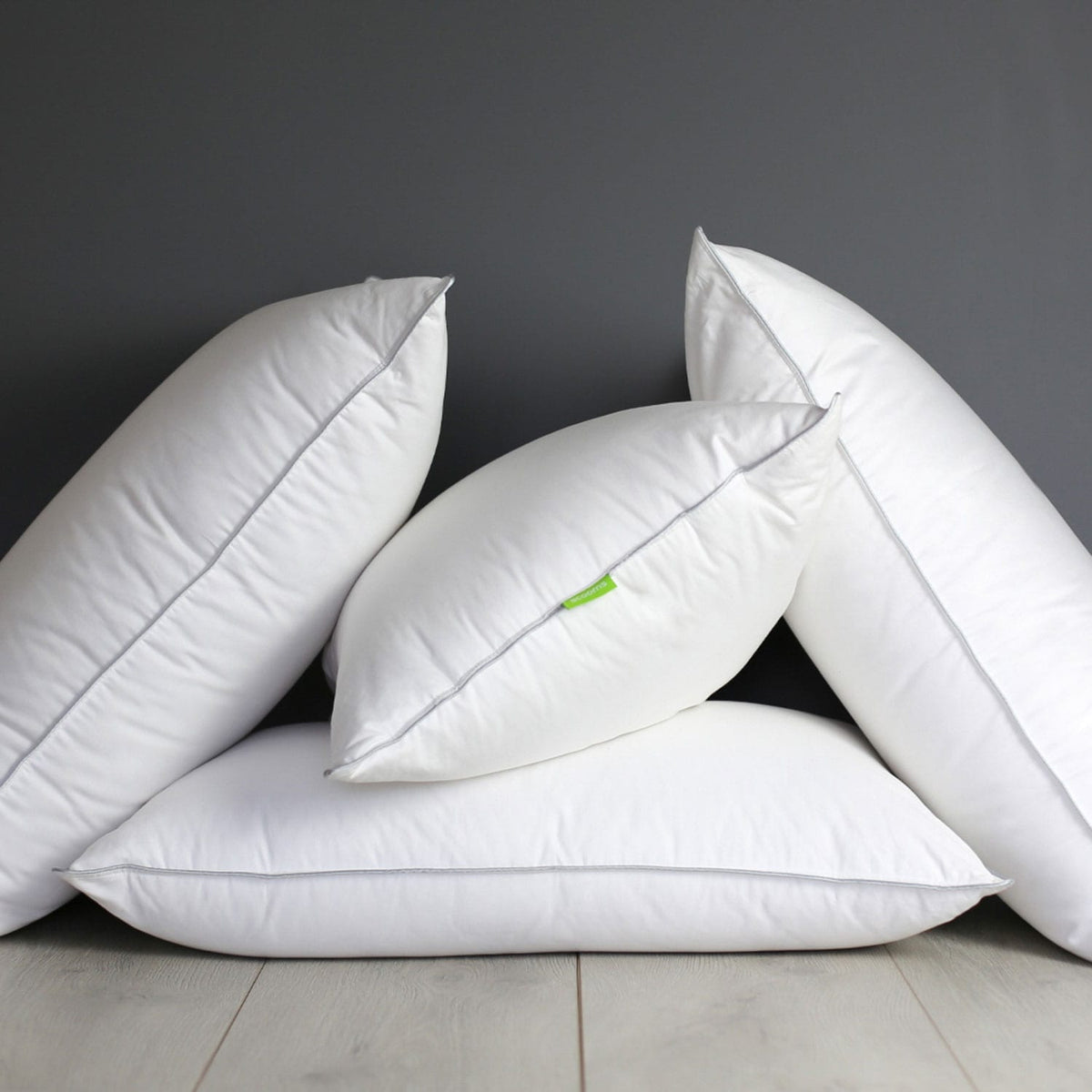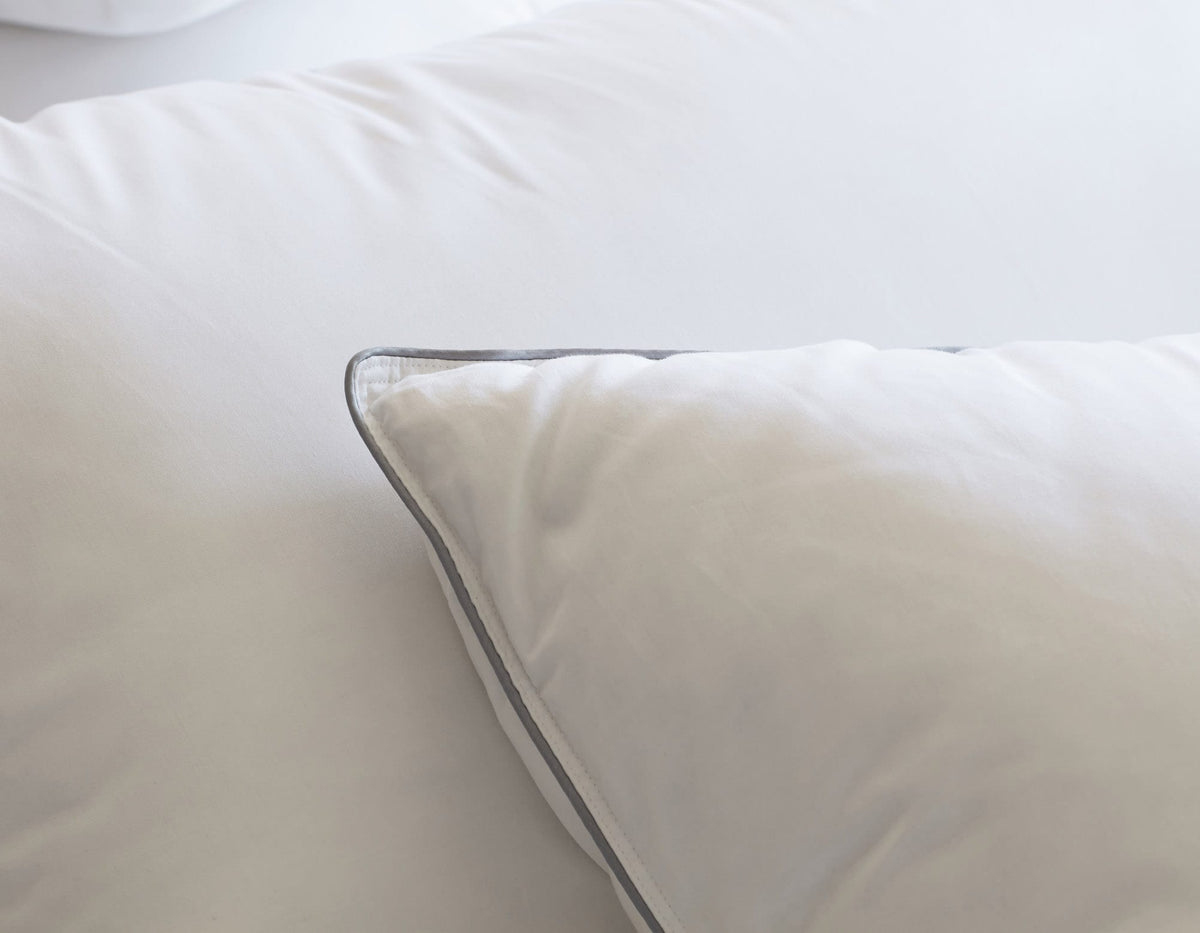The biggest pillow buying mistakes

A good pillow is essential for a restful night's sleep, but waiting too long to change your pillows or choosing the wrong one can lead to poor sleep quality, neck pain and health issues. Here are the most common pillow buying mistakes and how you can avoid them.
See our other guide on how to choose a new pillow.
- Keeping your old pillow for too long
- Choosing the wrong pillow filling
- Choosing the wrong pillow casing
- Ignoring pillow construction
- Not considering your sleeping position
- Too high or too low a pillow
- Not considering allergies
- Forgetting about temperature regulation
- Fake or low quality down
- Falling for sales and marketing scams
Keeping your old pillow for too long
A pillow gets a lot of use. Not only does it have the weight of your head on it every single night, but when you sleep, you sweat, shed skin cells and discharge the creams and lotions you may have applied to your face. All of these can be absorbed by your pillow. That’s why experts recommend changing your pillow every 1–2 years.
Many of us don’t follow this recommendation and put off or simply forget to buy a new pillow. However, a worn-out pillow will no longer provide the right support and may accumulate dust-mites and bacteria, all of which can disrupt your sleep and affect your health. So you really should be following what the experts say! See our guide to changing your pillow.

Choosing the wrong pillow filling
The filling material significantly affects the comfort, support and health credentials of a pillow. There are two types of pillow filling: synthetic and natural. At scooms, we always advocate choosing natural materials for bedding as these materials are breathable and sweat wicking. Synthetic filled pillows are often cheaper and although paying less for your pillows may seem appealing, they tend to loose shape and support quickly. Investing in a high-quality pillow ensures proper support, consistent comfort and a good night's sleep.
Natural fillings include:
- Down and feather: The ideal pillow filling; soft and luxurious. As down and feather are breathable, this filling does not hold onto moisture if aired and looked after properly. Make sure you choose the right mix of down and feather for your sleeping position, see below.
- Natural latex: Supportive, durable and hypoallergenic, but it can be expensive. Latex tends to be much firmer than other pillow fillings so it won't suit you if you like a softer feel. (Latex can also be synthetic so read the labelling carefully.)
- Wool: Eco-friendly, hypoallergenic and naturally insulating, a wool pillow can be a comfortable pillow option. Usually a medium to firm rather dense pillow feel, so don't go for this option if you prefer a softer, squidgier pillow. Wool pillows can have a slight odour.
Synthetic bedding materials are cheap to manufacture in vast quantities as they are made from petrochemicals. However, these may initially gas-off into the air which can be unpleasant. Some synthetic pillow fillings are made from microfibres, tiny threads of polyester plastic which are a major cause of micro-plastic pollution that can end up in our water supply when the pillow is washed. Synthetic pillow fillings are not an eco-friendly option.
Typical synthetic fillings include:
- Memory foam: ‘Developed by NASA', these contains high levels of VOCs and other chemicals. Supportive but can retain heat. Not washable.
- Polyester / Down alternative: Sometimes called 'feels like down'. Cheaper to purchase but can lack durability. These pillows can be frequently washed at hot temperatures but will release microfibres, causing pollution.
- Recycled plastic: Typically made from recycled plastic bottles. While they use less energy to make than using raw plastic, they’re still made from chemicals and contribute to micro-plastic pollution.
Choosing the wrong pillow casing
Often overlooked, a pillow casing will help your pillow keep its shape and protect the filling. We always suggest using high-quality cotton. Look for pillow casings that have been crafted with an especially tight weave as these will be dust-mite proof and down/feather proof.
Ignoring pillow construction
How a pillow is made will impact how long it retains its shape. There are two main types of construction:
- Chamber pillow construction: A firm inner core surrounded by a softer, squashier layer. These are more comfortable and hold their shape well.
- Bag construction: All the filling is stuffed into an outer case. Often used in cheaper pillows as it is easier to make. These type of pillows can loose their shape quite quickly.
Not considering your sleeping position
Different sleeping positions may require different levels of support, although many of us sleep in more than one position throughout the night:
- Side sleepers need a firmer, thicker pillow to keep their neck aligned with their head.
- Back sleepers benefit from a medium thick pillow that supports the natural curve of the neck.
- Stomach sleepers should opt for a softer, thinner pillow to prevent neck strain.
Too high or too low a pillow
A pillow that’s too high or too low can cause neck pain and misalignment. Select the right loft based on body size and sleeping style. The height of your pillow should ideally fit into the height of your neck.
Not considering allergies
If you suffer from allergies, choosing the wrong pillow can worsen symptoms. Opt for hypoallergenic materials like quality down or latex. Down and feather are breathable, so they help prevent dust-mites and allergens from accumulating. Avoid petrochemicals as these can produce harmful gases and microfibres.
Forgetting about temperature regulation
If you are a hot sleeper, a pillow made from breathable materials can enhance comfort and prevent night sweats. See our guide on the right bedding for night sweats.
Fake or low quality down
Not all down is the same. Some of the down that is described as Hungarian Goose down is fake or of a low quality. There are two ways to check. Products with genuine Hungarian down should be certified by the Hungarian Chamber of Commerce and the product should have a special holographic tag to certify this. The other is price. Quality authentic down is not cheap, if the down pillow seems too cheap, then it's probably not genuine.
Falling for sales and marketing scams
Avoid the sales tricks that many marketing teams perpetuate:
- Over-inflating the price of a pillow initially and then showing a discounted sale price to give the illusion of a deal.
- Special buy items - often low-quality pillows made at a cheap price point.
- Prices that seem too good to be true - authentic quality ingredients cost more. Check for certificates of authenticity.
Buying the right pillow is crucial for your sleep health and overall well-being. By avoiding these common mistakes, you can find a pillow that provides the perfect balance of comfort and support, ensuring better sleep and improved health.
Also in Pillows

How to choose a pillow?
Choose the best pillow by considering the pillow filling, the support the pillow offers, the size and any important accreditations, along with your favoured sleeping position.

How many pillows should you sleep with?
You should sleep on only one pillow. The right pillow should help your body maintain the ideal sleeping position throughout the night, keeping your head, neck and spine in neutral alignment.



